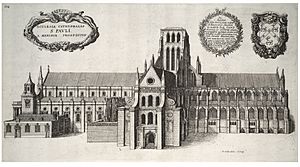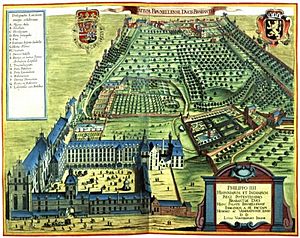Peter Philips facts for kids
Quick facts for kids
Peter Philips
|
|
|---|---|
| Born | 1560 Devonshire or London
|
| Died | 1628 Brussels
|
| Occupation | Organist, virginals teacher, Roman Catholic priest |
| Era | Tudor era |
Peter Philips (also known by names like Phillipps or Pierre Philippe) was a famous English composer and organ player. He was also a Catholic priest who had to leave England and live in Flanders (modern-day Belgium). He was one of the best keyboard players of his time. He often copied or changed Italian motets (a type of church music) and madrigals (a type of song) by other composers like Lassus and Palestrina. Some of his keyboard pieces are found in a famous collection called the Fitzwilliam Virginal Book. Philips also wrote many religious songs for choirs.
Contents
Peter Philips' Early Life and Career

Peter Philips was born around 1560 or 1561. He might have been born in Devonshire or London. From 1572 to 1578, he started his music journey as a boy singer, called a chorister. This was at St Paul's Cathedral in London. His teacher was Sebastian Westcott, who was Catholic. Westcott had also taught another famous composer, William Byrd, years before. Philips lived in Westcott's house and was left money in his will, showing they were close.
In 1582, Philips left England for good. He left because he was Catholic, and at that time, Catholics faced difficulties in England. He stayed briefly in Flanders before traveling to Rome. In Rome, he worked for Alessandro Farnese for three years. He also played the organ at the English Jesuit College there.
Life as an Exile and Challenges
In February 1585, while in Rome, Philips met another Catholic exile named Thomas Paget. Philips became a musician for Paget. They left Rome in March 1585 and traveled for several years. They visited places like Genoa, Madrid, Paris, Brussels, and finally Antwerp. Philips settled in Antwerp in 1590, and Paget died there the same year.
After settling, Philips got married. He earned a living by teaching children how to play the virginals, a type of keyboard instrument. This was a difficult way to make money. In 1593, he went to Amsterdam to meet a famous musician, likely Jan Pieterszoon Sweelinck. On his way back, someone accused Philips of being involved in a plan against Queen Elizabeth. He was put in jail for a short time in the Hague. While in jail, he probably wrote two sad keyboard pieces called Doloroso. Philips himself translated the charges against him, which showed he could speak Dutch. He was found innocent and set free.
Later Life and Important Roles

Philips' life got much better after his release. In 1597, he got a job in Brussels. He became the organist for the chapel of Albert VII, Archduke of Austria. Albert had become the governor of the Low Countries in 1595. After his wife and child passed away, Philips became a priest. This happened in either 1601 or 1609. He also received special church positions, called canonries, in Soignies in 1610 and in Béthune around 1622 or 1623. His closest music friend was Peeter Cornet, who played the organ for Archduchess Isabella, the Archduke's wife.
Peter Philips died in 1628, most likely in Brussels, where he was buried.
Peter Philips' Musical Works
Peter Philips wrote a lot of music. He composed hundreds of motets. He also wrote music for instruments alone, and for groups of instruments playing together, called consort music. His keyboard pieces are similar to those of other English "virginalist" composers. However, his choir music, while sometimes having English touches, mostly sounds like the music of Italian composers from his time.
One of his earliest known pieces is a pavan (a slow dance) from 1580. It is found in the Fitzwilliam Virginal Book. This book contains 19 of his 27 known keyboard pieces. These include pavans, galliards (a lively dance), and fantasias (free-form pieces). The person who likely put together the Fitzwilliam Virginal Book, Francis Tregian the Younger, was also Catholic. They probably knew each other. Many of Philips' pieces in the book are based on music by Italian composers.
Philips also published many other works:
- 1591: His publisher in Antwerp, Pierre Phalèse the Younger, printed his collection of madrigals called Melodia Olympica. More editions came out in 1594 and 1611.
- 1596: Philips published his Primo Libro de Madrigali a sei voci, a book of madrigals for six voices.
- 1598: Another book of madrigals for eight voices was published.
- 1603: A different set of madrigals for six voices was published.
- 1612: The first set of Cantiones Sacrae (sacred songs) for five voices was printed.
- 1613: A second set of Cantiones Sacrae Octonis Vocibus for a double choir of eight voices was released.
- 1616: Les Rossignols spirituels was published. This book had popular songs changed to have religious words in Latin and French.
- 1623: He wrote Litanies to Loreto, which are prayers.
- 1628: His last known work, Paradisus sacris cantionibus consitus, was published.
Images for kids



